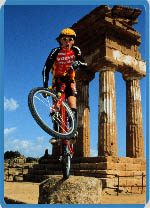|
At the Exploratorium, our experimentation has convinced
us that you turn your wheel to the right to throw your weight to the left.
To change direction, you need the help of a force outside of yourself and
the bicycle. Trying to change direction without the help of an outside force
is like trying to pull yourself up by your own shoelaces. It doesn't work.
If you were to try to fling yourself to one side, you would go in one direction
and your bike would go in the other, counterbalancing your weight shift.
When you turn your front wheel to the right, your bike
heads to the right, but your body tends to keep going straight. If you are
traveling fast and you twist the wheel sharply, your momentum may cause
you and your bicycle to part company when your bike turns and you continue
in a straight course. If you turn the wheel less sharply, you still feel
the effect of your forward momentum: you feel like you are thrown to the
left. An outside observer, like the one who drew the sketch below, would
see that the push to the left is really just your tendency to continue on
a straight course, interrupted by the turn of the bike's wheel. This push
lets you lean your bike quickly and turn sharply.
Since a bicycle is in a constant state of imbalance, a cyclist can also
start a turn just by taking advantage of the beginning of a fall to one
side and transforming this fall into a leisurely turn.
|
|
|

IMAGE COURTESY OF CANNONDALE BICYCLES
|
Libor Karas--Trials Expert
"Trials competition is basically bicycle stunt riding over different
obstacles, cars, picnic tables, rocks, mud, and water." explained Libor
Karas, two-timeWorld Champion Trials rider. The following QuickTime movie
demonstrates some of the skills that Libor has developed.
Libor Karas QuickTime Movie
(2.4 megs)
The Trials bicycle that Libor rides is smaller than most mountain bikes.
This helps him control the bicycle with amazing accuracy. Control is important
since Libor does some of his stunts on ledges of tall buildings. Occasionally
he even jumps between buildings. When watching him perform, the bicycle
appears almost to be an extension of his body.
|
|

